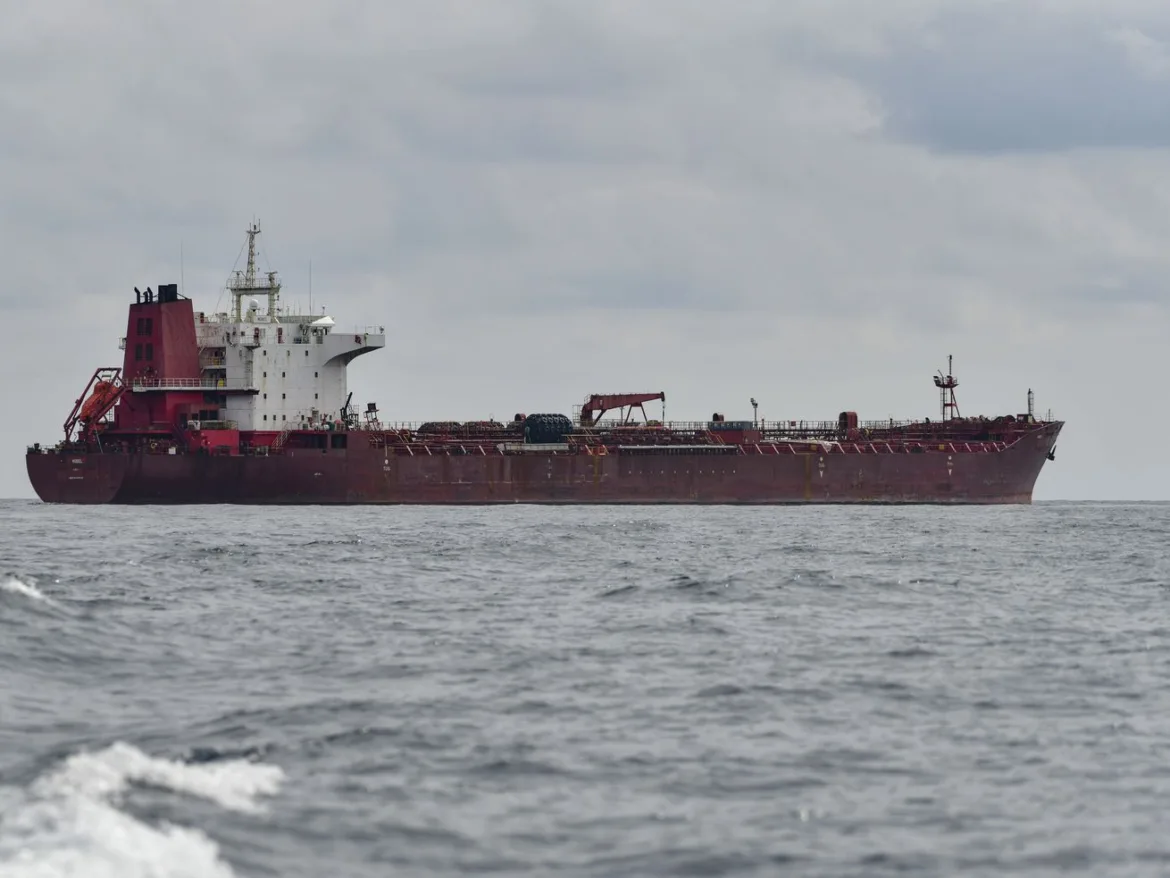The world’s next big maritime catastrophe could involve sanctions-dodging rustbuckets.
On March 2, just as it was rounding the northern tip of Denmark, an oil tanker called the Andromeda Star collided with another ship. Thankfully, the 700,000-barrel capacity Andromeda Star was empty at the time, as it was making its way to Russia to pick up oil for export. If it had been on its way back, its cargo hold full of crude, a little-noticed maritime incident might have become a much bigger story, one that connects to both the ongoing war in Ukraine and the world’s unbroken dependence on oil.
The Andromeda Star is part of what has been called the “shadow fleet” transporting Russian oil to world markets. This fleet emerged in response to the international sanctions slapped on Russia’s oil industry in the wake of the full-scale invasion of Ukraine, to reduce the profits from its most valuable international commodity. The commodities trading company Trafigura has estimated the size of the fleet at around 600 ships, though some estimates are much higher.
The shadow fleet is of growing concern not only because of the revenue that these oil shipments bring to Moscow, which fuels its more than two-year-old war, but because of the nature of the ships themselves.
“They tend to be older, they may also be less well maintained, they are run by less experienced crews, and they carry less insurance than they should,” Erik Broekhuizen, head of tanker research at Poten & Partners, an oil and gas consulting firm, told Vox.
The 15-year-old Andromeda Star was a relative spring chicken by shadow fleet standards. “The lifespan of a ship is typically 20- to 25-year range, but most reputable ship owners typically sell ships around 15 years,” said Broekhuizen. “In a normal market, they’d then be recycled.”
But the shadow fleet has created a booming market for old tankers, including many that are over 20 years old. The average age of tankers departing the Russian Baltic Sea port of Kaliningrad is now close to 30 years old. That makes it more likely that the ships have fallen into poor conditions and makes them more prone to accidents.
Another shadowy aspect of Russia’s new fleet: Often no one is quite sure who the ships belong to. The Andromeda Star’s owner is not listed on public databases. It is managed by Margao Marine Solutions, a “one-person company” based in Goa, India, which did not return an email from Vox seeking comment. And as with many shadow fleet ships, it’s not clear what if any insurance it was carrying.
As this week’s disaster in Baltimore — where a Singapore-flagged cargo ship caused the collapse of the Francis Scott Key Bridge — showed, the question of liability and responsibility can be messy even in maritime accidents involving one of the world’s largest and most reputable shipping companies. The nightmare scenario many governments are now contemplating is that one of these shadily owned tankers could be involved in a major oil spill and there would be no one — or at least no one authorities can track down — liable for the clean-up.
“There is an ecological disaster waiting to happen. That’s just the reality,” David O’Sullivan, the European Union’s sanctions envoy, told Vox during a meeting with reporters in Washington last week. “This is something the international community needs to worry about.”
Unfortunately, given the often murky multinational structure of the shipping world, it’s also something that the international community has few good options to address.
The Russian oil compromise
The emergence of the shadow fleet is one result of the dueling prerogatives of the international sanctions response to Russia’s war in Ukraine: One, cut the money flowing to Russia’s government and military; two, avoid major disruptions to a world economy that still relies hugely on the flow of oil.
Shortly after the invasion in 2022, the US banned imports of Russian oil, which the US already wasn’t buying much of. But the EU has also slashed its purchases of Russian oil, which is a lot more significant: Before the war, the bloc accounted for about 45 percent of Russia’s oil exports. Now, it’s about 5 percent.
Initially, the EU had planned to also enact a ban on European companies trading and shipping Russian oil, in order to prevent other countries from buying it, but the US government was concerned about the effect this would have on global oil prices. (A similar dynamic has emerged in recent weeks with reports that the US has pressured Ukraine to dial back its aerial attacks on Russia’s oil refineries, which are also having an impact on global prices by reducing supply.)
According to one analysis from just after the invasion, disrupting Russia’s seaborne exports with the kind of strict sanctions that, for instance, the US has applied to Iran in the past, could have pushed global oil prices to over $200 a barrel, more than twice their current level.
So, a workaround was found. A coalition of Western countries including the EU and the G7 implemented a “price cap” which allowed Russian oil sold below $60 a barrel — about $20 below the current market price — to use Western shipping infrastructure and insurance. The goal, as the US Treasury Department defined it, is to “limit Kremlin profits while maintaining stable energy markets.”
To some extent, this system has worked. Russia’s oil exports, by volume, are back to where they were before the war. New customers in China, India, and Turkey have made up for the loss of the European market. (Thanks to some creative accounting, some oil has even reportedly found its way into the US military’s supply chain.) Russia’s oil revenues, though, have declined significantly. A recent analysis by the American Enterprise Institute estimated that the discounts may have cost Russia around $50 billion in lost revenue in 2022 and 2023. That’s almost a quarter of what Russia has spent on its military operations in Ukraine according to a recent US estimate.
The thing is, experts say only a small fraction of Russia’s oil exports — maybe 20-30 percent, Broekhuizen estimates — are complying with the price cap. Russian oil is currently trading around $72 a barrel, which is below global averages but above the cap. This is where the shadow fleet comes in.
These types of shadily registered ships meant specifically to skirt oil sanctions aren’t new, said Elisabeth Braw, a senior fellow at the Atlantic Council who has written extensively on the fleet, but the involvement of the world’s second-largest oil exporter was a game changer.
”This was a strategy that was initiated long before Ukraine for other sanctioned countries,” Braw told Vox. “North Korea has been conducting a shadow economy using vessels that don’t officially exist for years. Venezuela and Iran have as well. But Russia’s involvement was a sort of quantum leap that brought this economy out of the shadows.”
Trouble at sea
“For the first time in many decades, safety at sea is becoming worse, not better, and it’s really because of the shadow fleet,” Jan Stockbruegger, a political scientist specializing in maritime security at the University of Copenhagen, told Vox.
The Andromeda Star incident was far from the first or the most troubling incident involving shadow tankers. The most dramatic and deadly took place in May of last year, when the Pablo, a 26-year-old tanker, exploded in Malaysian waters, killing three crew. Thankfully, the Pablo had already offloaded its cargo in China, but with no apparent insurance and no reachable owner, the wreckage of the ship remained stranded until Malaysian authorities finally towed it to a scrapyard.
As documented in a recent Atlantic Council report, shadow fleet ships have had to be rescued in the Bay of Gibraltar, have run aground near the Chinese port of Qingdao, and have drifted for days after losing power in Indonesia.
Last August, when an Indian seafarer disappeared from the tanker where he was working, transporting Russian oil to India and Turkey, his family complained they couldn’t get basic information about his disappearance from the ship’s Dubai-based manager.
In a confluence of two geopolitical crises, a Panama-flagged, India-affiliated ship carrying oil from Russia was attacked by Houthi rebels in the Red Sea in January. The Houthis have vowed not to attack Russian or Chinese ships as part of their ongoing campaign to disrupt trade between countries linked to Israel, but in this case may have been thrown off by the fact that the ship had a UK owner until a few months prior.
Troubling as all these incidents are, they pale in comparison to what would happen if one of these ships, most of which carry insurance that, as the Financial Times has put it, would be “impossible to claim against,” was involved in a major oil spill. A combination of the country where the spill takes place and an international organization known as the International Oil Pollution Compensation Funds, which reimburses victims of oil spills when the damage exceeds what the shipowner or insurer is able or willing to pay, could be left with responsibility for the mess.
Other factors compound the risks. Last September, Bloomberg reported that two aging shadow fleet tankers had carried out a risky ship-to-ship oil transfer off the coast of Greece, having turned off their transponders to conceal their location. The majority of the ships transporting oil through the Danish Strait, a narrow and often tricky waterway as the Andromeda Star learned, have been refusing to take on the specialized Danish navigators that often assist ships making the journey. Often these ships refuse any contact with Danish authorities, a break from what was common practice pre-war.
Russia has been keen to increase the use of its Northern Sea Route through the Arctic to China, including authorizing shipments by tankers that don’t have the reinforced “ice-class” hulls normally required for the trip. Even in summer, in the era of global warming, Arctic ice can be unpredictable, and using these thin-hulled tankers only increases the risk of accidents that could devastate a vulnerable ecology.
Out of the shadows
What can be done to crack down on the shadow fleet?
“We are trying to shut off the supply of these tankers to make it more difficult for people to sell end-of-life tankers to the Russians,” said O’Sullivan, the EU sanctions envoy. “We’re also trying to be tougher in the enforcement of the documentation which needs to go with [these sales.]”
In February, the US slapped sanctions on Sovcomflot, Russia’s largest shipping company and a leading operator of oil tankers, which prompted India to halt oil shipments from the company. But many of Sovcomflot’s tankers have already been transferred to offshore companies. Dubai, famed for its political neutrality and lack of income taxes, has been a particularly popular location for these companies. The US has also been sanctioning these companies and individual companies for violating the price cap.
The US government has also been ramping up pressure on the countries where these ships are registered, which are responsible for ensuring safety and maintenance standards on the vessels that fly their flag. As a result, Russia’s oil fleet has been shifting away from popular flag countries like Liberia and the Marshall Islands. The number of ships flying the flag of the West African nation of Gabon, on the other hand, has surged dramatically since the beginning of this year. (The ill-fated Pablo was among the shadow fleet tankers flying the Gabon flag.) Mongolia, more than 400 miles from the nearest ocean, has also become a popular flag of convenience.
The Financial Times also reported last fall that the EU was considering plans under which Denmark, which controls the straits at the entrance to the Baltic Sea through which 60 percent of Russia’s oil exports pass, could be given the task of inspecting or even blocking ships that were not found to be carrying recognized insurance.
“The most practical step would be for coastal states to essentially assess every vessel planning to sail through their waters,” said the Atlantic Council’s Braw. “It would be extreme and very time-consuming.” It could also prompt retaliation or legal challenge from Russia.
The plan has not yet been implemented, though the incident with the Andromeda Star may give it some new momentum.
Stockbruegger suggests that another strategy would be to make it more appealing for officially registered and insured global shippers to participate in the Russian oil trade, under the price cap. But given the risks involved and the arcane nature of sanctions laws, which could leave them exposed to legal difficulties, “It would take a lot of convincing for these companies.”
Assuming that countries like India and China won’t stop buying discounted oil — and given that the US doesn’t actually want them to, particularly heading into an election year — the continued existence of the shadow fleet in some form may be inevitable, even as these ships bounce around from flag to flag and owner to owner and port to port. A world that is rapidly dividing politically, even as it remains economically interconnected, has created some murky backwaters, including one that a fleet of mysteriously owned, aging rustbuckets has rushed in to fill.
For now, Russian oil continues to course through the world’s economies, just as Russia’s adversaries intended. Hopefully, it will stay out of the world’s oceans.



